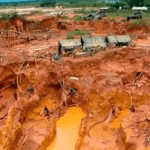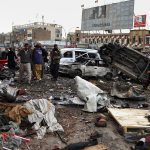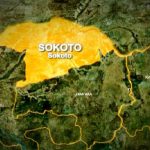Ten more miners’ bodies were recovered from a collapsed coal pit in Southern Pakistan on Wednesday, raising the total number of deaths to 12.
On Tuesday evening, a gas explosion ripped through a private coal pit in Khost’s mining region, trapping hundreds of workers 800 feet (244 meters) beneath.
This region is infamous for its hazardous working conditions and inadequate safety regulations.
A gas explosion in a coal mine in southern Poland in April 2022 killed four persons and left seven missing.
Also, eighteen miners were confirmed dead in 2020 after a carbon monoxide leak at a coal mine in southwestern China, state media reported, with rescue efforts underway to reach five others still trapped underground.
Prime Minister Shehbaz Sharif issued a statement expressing “profound sorrow and grief over the loss of precious lives”.
It was initially thought that there were only ten miners involved in the cave-in about 80 kilometres (50 miles) east of Quetta city.
Rescue workers from the government mining department and the disaster management agency toiled through the night to reach them.
A group of eight people who were attempting to rescue their colleagues also became trapped for several hours, but were later brought to safety by a government rescue team — some of them unconscious.
Deadly incidents are not uncommon in Pakistan’s mines, which are known for hazardous working conditions and poor safety standards.
Balochistan is Pakistan’s largest but poorest province, and is rich in natural resources, which locals have long complained are not shared fairly among their communities.
In May 2018, 23 people were killed and 11 more wounded after gas explosions tore through two neighbouring coal mines in the same region.
Ten more miners’ bodies were recovered from a collapsed coal pit in Southern Pakistan on Wednesday, raising the total number of deaths to 12.
On Tuesday evening, a gas explosion ripped through a private coal pit in Khost’s mining region, trapping hundreds of workers 800 feet (244 meters) beneath.
This region is infamous for its hazardous working conditions and inadequate safety regulations.
A gas explosion in a coal mine in southern Poland in April 2022 killed four persons and left seven missing.
Also, eighteen miners were confirmed dead in 2020 after a carbon monoxide leak at a coal mine in southwestern China, state media reported, with rescue efforts underway to reach five others still trapped underground.
Prime Minister Shehbaz Sharif issued a statement expressing “profound sorrow and grief over the loss of precious lives”.
It was initially thought that there were only ten miners involved in the cave-in about 80 kilometres (50 miles) east of Quetta city.
Rescue workers from the government mining department and the disaster management agency toiled through the night to reach them.
A group of eight people who were attempting to rescue their colleagues also became trapped for several hours, but were later brought to safety by a government rescue team — some of them unconscious.
Deadly incidents are not uncommon in Pakistan’s mines, which are known for hazardous working conditions and poor safety standards.
Balochistan is Pakistan’s largest but poorest province, and is rich in natural resources, which locals have long complained are not shared fairly among their communities.
In May 2018, 23 people were killed and 11 more wounded after gas explosions tore through two neighbouring coal mines in the same region.
Ten more miners’ bodies were recovered from a collapsed coal pit in Southern Pakistan on Wednesday, raising the total number of deaths to 12.
On Tuesday evening, a gas explosion ripped through a private coal pit in Khost’s mining region, trapping hundreds of workers 800 feet (244 meters) beneath.
This region is infamous for its hazardous working conditions and inadequate safety regulations.
A gas explosion in a coal mine in southern Poland in April 2022 killed four persons and left seven missing.
Also, eighteen miners were confirmed dead in 2020 after a carbon monoxide leak at a coal mine in southwestern China, state media reported, with rescue efforts underway to reach five others still trapped underground.
Prime Minister Shehbaz Sharif issued a statement expressing “profound sorrow and grief over the loss of precious lives”.
It was initially thought that there were only ten miners involved in the cave-in about 80 kilometres (50 miles) east of Quetta city.
Rescue workers from the government mining department and the disaster management agency toiled through the night to reach them.
A group of eight people who were attempting to rescue their colleagues also became trapped for several hours, but were later brought to safety by a government rescue team — some of them unconscious.
Deadly incidents are not uncommon in Pakistan’s mines, which are known for hazardous working conditions and poor safety standards.
Balochistan is Pakistan’s largest but poorest province, and is rich in natural resources, which locals have long complained are not shared fairly among their communities.
In May 2018, 23 people were killed and 11 more wounded after gas explosions tore through two neighbouring coal mines in the same region.
Ten more miners’ bodies were recovered from a collapsed coal pit in Southern Pakistan on Wednesday, raising the total number of deaths to 12.
On Tuesday evening, a gas explosion ripped through a private coal pit in Khost’s mining region, trapping hundreds of workers 800 feet (244 meters) beneath.
This region is infamous for its hazardous working conditions and inadequate safety regulations.
A gas explosion in a coal mine in southern Poland in April 2022 killed four persons and left seven missing.
Also, eighteen miners were confirmed dead in 2020 after a carbon monoxide leak at a coal mine in southwestern China, state media reported, with rescue efforts underway to reach five others still trapped underground.
Prime Minister Shehbaz Sharif issued a statement expressing “profound sorrow and grief over the loss of precious lives”.
It was initially thought that there were only ten miners involved in the cave-in about 80 kilometres (50 miles) east of Quetta city.
Rescue workers from the government mining department and the disaster management agency toiled through the night to reach them.
A group of eight people who were attempting to rescue their colleagues also became trapped for several hours, but were later brought to safety by a government rescue team — some of them unconscious.
Deadly incidents are not uncommon in Pakistan’s mines, which are known for hazardous working conditions and poor safety standards.
Balochistan is Pakistan’s largest but poorest province, and is rich in natural resources, which locals have long complained are not shared fairly among their communities.
In May 2018, 23 people were killed and 11 more wounded after gas explosions tore through two neighbouring coal mines in the same region.
Ten more miners’ bodies were recovered from a collapsed coal pit in Southern Pakistan on Wednesday, raising the total number of deaths to 12.
On Tuesday evening, a gas explosion ripped through a private coal pit in Khost’s mining region, trapping hundreds of workers 800 feet (244 meters) beneath.
This region is infamous for its hazardous working conditions and inadequate safety regulations.
A gas explosion in a coal mine in southern Poland in April 2022 killed four persons and left seven missing.
Also, eighteen miners were confirmed dead in 2020 after a carbon monoxide leak at a coal mine in southwestern China, state media reported, with rescue efforts underway to reach five others still trapped underground.
Prime Minister Shehbaz Sharif issued a statement expressing “profound sorrow and grief over the loss of precious lives”.
It was initially thought that there were only ten miners involved in the cave-in about 80 kilometres (50 miles) east of Quetta city.
Rescue workers from the government mining department and the disaster management agency toiled through the night to reach them.
A group of eight people who were attempting to rescue their colleagues also became trapped for several hours, but were later brought to safety by a government rescue team — some of them unconscious.
Deadly incidents are not uncommon in Pakistan’s mines, which are known for hazardous working conditions and poor safety standards.
Balochistan is Pakistan’s largest but poorest province, and is rich in natural resources, which locals have long complained are not shared fairly among their communities.
In May 2018, 23 people were killed and 11 more wounded after gas explosions tore through two neighbouring coal mines in the same region.
Ten more miners’ bodies were recovered from a collapsed coal pit in Southern Pakistan on Wednesday, raising the total number of deaths to 12.
On Tuesday evening, a gas explosion ripped through a private coal pit in Khost’s mining region, trapping hundreds of workers 800 feet (244 meters) beneath.
This region is infamous for its hazardous working conditions and inadequate safety regulations.
A gas explosion in a coal mine in southern Poland in April 2022 killed four persons and left seven missing.
Also, eighteen miners were confirmed dead in 2020 after a carbon monoxide leak at a coal mine in southwestern China, state media reported, with rescue efforts underway to reach five others still trapped underground.
Prime Minister Shehbaz Sharif issued a statement expressing “profound sorrow and grief over the loss of precious lives”.
It was initially thought that there were only ten miners involved in the cave-in about 80 kilometres (50 miles) east of Quetta city.
Rescue workers from the government mining department and the disaster management agency toiled through the night to reach them.
A group of eight people who were attempting to rescue their colleagues also became trapped for several hours, but were later brought to safety by a government rescue team — some of them unconscious.
Deadly incidents are not uncommon in Pakistan’s mines, which are known for hazardous working conditions and poor safety standards.
Balochistan is Pakistan’s largest but poorest province, and is rich in natural resources, which locals have long complained are not shared fairly among their communities.
In May 2018, 23 people were killed and 11 more wounded after gas explosions tore through two neighbouring coal mines in the same region.
Ten more miners’ bodies were recovered from a collapsed coal pit in Southern Pakistan on Wednesday, raising the total number of deaths to 12.
On Tuesday evening, a gas explosion ripped through a private coal pit in Khost’s mining region, trapping hundreds of workers 800 feet (244 meters) beneath.
This region is infamous for its hazardous working conditions and inadequate safety regulations.
A gas explosion in a coal mine in southern Poland in April 2022 killed four persons and left seven missing.
Also, eighteen miners were confirmed dead in 2020 after a carbon monoxide leak at a coal mine in southwestern China, state media reported, with rescue efforts underway to reach five others still trapped underground.
Prime Minister Shehbaz Sharif issued a statement expressing “profound sorrow and grief over the loss of precious lives”.
It was initially thought that there were only ten miners involved in the cave-in about 80 kilometres (50 miles) east of Quetta city.
Rescue workers from the government mining department and the disaster management agency toiled through the night to reach them.
A group of eight people who were attempting to rescue their colleagues also became trapped for several hours, but were later brought to safety by a government rescue team — some of them unconscious.
Deadly incidents are not uncommon in Pakistan’s mines, which are known for hazardous working conditions and poor safety standards.
Balochistan is Pakistan’s largest but poorest province, and is rich in natural resources, which locals have long complained are not shared fairly among their communities.
In May 2018, 23 people were killed and 11 more wounded after gas explosions tore through two neighbouring coal mines in the same region.
Ten more miners’ bodies were recovered from a collapsed coal pit in Southern Pakistan on Wednesday, raising the total number of deaths to 12.
On Tuesday evening, a gas explosion ripped through a private coal pit in Khost’s mining region, trapping hundreds of workers 800 feet (244 meters) beneath.
This region is infamous for its hazardous working conditions and inadequate safety regulations.
A gas explosion in a coal mine in southern Poland in April 2022 killed four persons and left seven missing.
Also, eighteen miners were confirmed dead in 2020 after a carbon monoxide leak at a coal mine in southwestern China, state media reported, with rescue efforts underway to reach five others still trapped underground.
Prime Minister Shehbaz Sharif issued a statement expressing “profound sorrow and grief over the loss of precious lives”.
It was initially thought that there were only ten miners involved in the cave-in about 80 kilometres (50 miles) east of Quetta city.
Rescue workers from the government mining department and the disaster management agency toiled through the night to reach them.
A group of eight people who were attempting to rescue their colleagues also became trapped for several hours, but were later brought to safety by a government rescue team — some of them unconscious.
Deadly incidents are not uncommon in Pakistan’s mines, which are known for hazardous working conditions and poor safety standards.
Balochistan is Pakistan’s largest but poorest province, and is rich in natural resources, which locals have long complained are not shared fairly among their communities.
In May 2018, 23 people were killed and 11 more wounded after gas explosions tore through two neighbouring coal mines in the same region.














